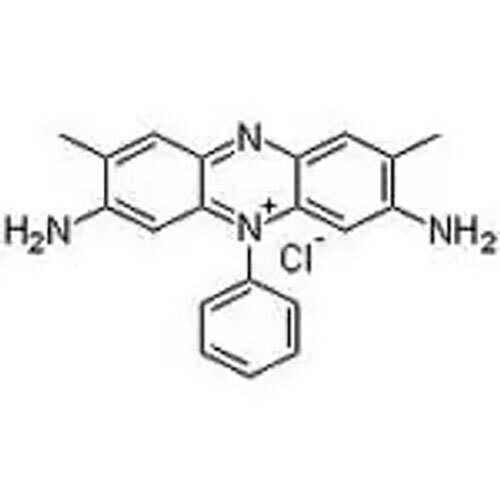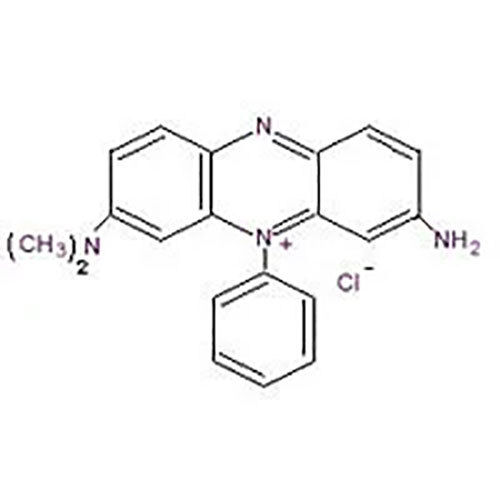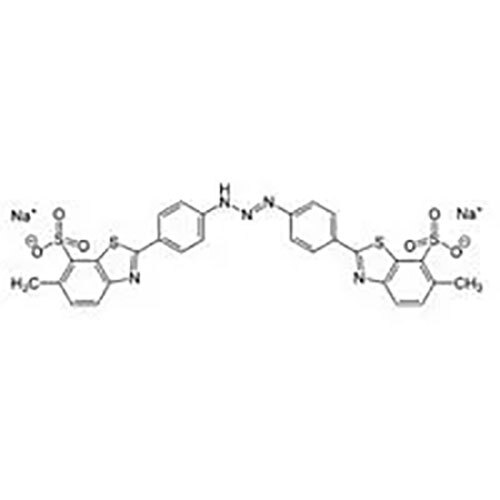Safranine O
Safranine O Specification
- Molecular Formula
- C20H19ClN4
- Ph Level
- ~7 (1% water solution)
- Usage
- Used as staining agent in laboratories
- Purity
- >85%
- Size
- Depends on packaging (typically 10g, 25g, 100g, 500g, 1kg)
- Molecular Weight
- 350.85 g/mol
- Density
- Gram per cubic centimeter(g/cm3)
- Packaging Type
- Plastic Bottle, HDPE Drum, Glass Bottle
- Storage Instructions
- Store in tightly closed container, in a cool, dry place, protected from light
- Boiling point
- Not available (decomposes before boiling)
- Shelf Life
- 5 years when properly stored
- Physical State
- Solid
- Grade
- Laboratory Reagent Grade
- Type
- Cationic Dye / Biological Stain
- Application
- Biological staining, microscopy, textile dye, research
- Purity(%)
- >85%
Safranine O Trade Information
- Minimum Order Quantity
- 100 Kilograms
- Supply Ability
- 50000 Kilograms Per Week
- Delivery Time
- 3-7 Days
About Safranine O
Safranine O:-
We are among the leading manufacturers and exporters of Safranine O, which is is a biological stain for application in histology and cytology process. It is a cationic dye for staining acidic proteoglycan that are found in cartilage tissues and function as indicator cell chondrogenesis. We have in our stock large amount of Safranine O, which is available in powdered form. This physical property enables it to dissolve it in de-ionized water easily for making solutions of staining dye. The product is of authentic quality with accurate composition and is used in medical lab process for testing purpose. It shows orange-red color when bound with glycosaminoglycan
Some of the notable aspects of Safranine O are:
- Accurate composition
- Good biological stain that also works as counterstain in some processes
- Available in powdered form
- Market leading prices
MOQ 50kg
| Specification | |
|---|---|
| Chemical Name | 3, 7-diamino-2,8-dimethyl-5-phenyl-phenazinium chloride |
| C.I.No. | 50240 |
| C.I.Genetic Name | Basic Red 2 |
| C.A.S. NO | 477-73-6 |
| Chemical Formula | C20H19ClN4 |
| Molecular Weight | 350.85 gm/mole |
| Dye Content (Spectrophotometry) | =>98% |
| Absorption Max (50% Ethanol) | = 530 - 534 nm |
| Absorptivity (A1%/1cm., in 50% Ethanol) | = > 1425 |
| Loss On Drying (110° c) | = < 4% |
| Powder Appearance | Crystal greenish |
Versatile Biological Stain and Redox Indicator
Safranine O is indispensable in laboratories for its multifaceted applications. As a cationic dye with a max of 520 nm in water, it provides reliable staining for tissues and cells, supporting critical microscopy workflows. It is also suitable for use as a redox indicator in metabolic and biochemical assays. Its compatibility with various solvents and neutral pH make it highly adaptable for numerous biological and research protocols.
Reliable Quality and Convenient Packaging
Manufactured under stringent quality standards, Safranine O features a purity greater than 85%, ensuring dependable results for both research and industrial use. It is packed in secure containers such as HDPE drums, plastic, or glass bottles, to maintain product stability over a shelf life of 5 years. Packaging sizes range from small laboratory vials to bulk quantities, meeting the needs of labs and suppliers alike.
FAQs of Safranine O:
Q: How is Safranine O typically used in laboratory settings?
A: Safranine O is commonly used as a biological stain in microscopy, where it highlights cellular structures, and as a redox indicator to assess metabolic activity. It is also utilized in textile dyeing and various research applications that require a reliable, cationic dye.Q: What benefits does Safranine O offer as a biological stain?
A: Safranine O offers clear and vivid staining of cell structures, contributing to accurate visualization in histology and cytology studies. Its high solubility in water and ethanol, as well as a near-neutral pH in dilute solution, ensures compatibility with common laboratory protocols.Q: Where should Safranine O be stored for optimal stability?
A: Safranine O should be stored in tightly closed containers, in a cool, dry place, and protected from direct light. Proper storage under these conditions preserves its stability, extending its shelf life up to 5 years.Q: What safety considerations should be observed when handling Safranine O?
A: According to GHS guidelines, Safranine O is not classified as hazardous. However, standard laboratory safety practicessuch as wearing gloves and gogglesare recommended when handling any dye or reagent.Q: When is Safranine O preferred over other stains or indicators?
A: Safranine O is chosen when a cationic dye or redox indicator is required, particularly for staining plant tissues or distinguishing between gram-positive and gram-negative bacteria in microbiological assays.Q: What are the available packaging options and sizes for Safranine O?
A: Safranine O is supplied in packaging types including plastic bottles, HDPE drums, and glass bottles. Sizes typically range from 10g for laboratory use to 1kg or more for bulk requirements, ensuring suitability for dealers, exporters, and research institutions.

Price:
- 50
- 100
- 200
- 250
- 500
- 1000+
More Products in Biological Stains Category
Janus Green B
Price 50 INR
Minimum Order Quantity : 100 Kilograms
Purity(%) : ~90%
Molecular Weight : 511.06 g/mol
Storage Instructions : Store in a cool, dry place, protected from light
Purity : ~90%
Basic Violet 5 / Dimethyl Safranine
Price 65 INR
Minimum Order Quantity : 100 Kilograms, ,
Purity(%) : 99%
Molecular Weight : 350.86 g/mol
Storage Instructions : Store in a cool, dry place, tightly closed
Purity : 99%
Trypan Blue
Price 80 INR
Minimum Order Quantity : 100 Kilograms
Purity(%) : 99%
Molecular Weight : 960.8 g/mol
Storage Instructions : Store at room temperature, protect from light
Purity : 99%
Titan Yellow
Price 90 INR
Minimum Order Quantity : 100 Kilograms
Purity(%) : 98%
Molecular Weight : 377.41 g/mol
Storage Instructions : Store in cool, dry place. Keep tightly closed.
Purity : 98%
 |
MEGHA INTERNATIONAL
All Rights Reserved.(Terms of Use) Developed and Managed by Infocom Network Private Limited. |
 English
English Spanish
Spanish French
French German
German Italian
Italian Chinese (Simplified)
Chinese (Simplified) Japanese
Japanese Korean
Korean Arabic
Arabic Portuguese
Portuguese
 Send Inquiry
Send Inquiry




